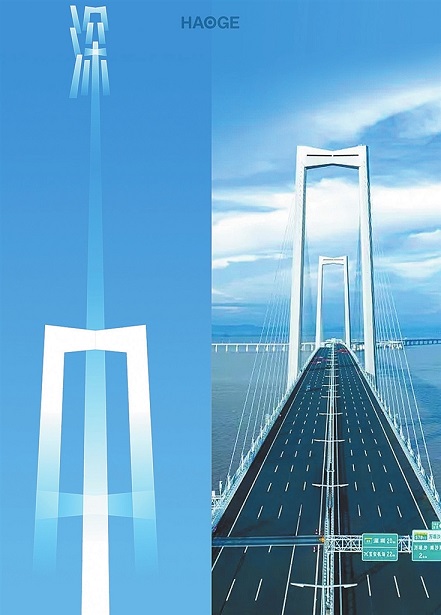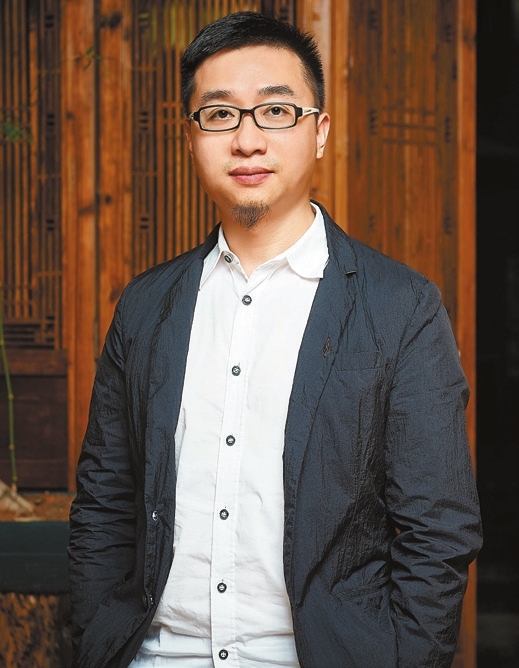Shenzhen
 2024/7/4
2024/7/4
 source: Shenzhen Daily
source: Shenzhen Daily
 Print
Print

The design from HAOGE TYPE, a firm specializing in custom Chinese typography, deconstructs the Chinese characters “深” (Shenzhen) and “中” (Zhongshan) and integrates them with the architectural features of the Shenzhong Bridge. Photos courtesy of HAOGE TYPE

Zhang Hao, founder and design director of HAOGE TYPE.
Liu Yangyang
524652046@qq.com
AFTER the opening of the Shenzhong (Shenzhen-Zhongshan) Link on June 30, hundreds of thousands of posts using the hashtag “深中通道” (#ShenzhongLink) appeared on Xiaohongshu, one of China’s most popular social media platforms.
Amid this sea of content, one creative design stood out. It cleverly deconstructs the Chinese characters “深” (Shenzhen) and “中” (Zhongshan) and integrates them with the architectural features of the Shenzhong Bridge. This not only accentuates the majestic structure of the Shenzhong Link but also symbolizes the project as a solid bond linking Shenzhen and Zhongshan.
This eye-catching work was created by HAOGE TYPE, a design firm specializing in custom Chinese typography.
Characters need
haute couture too
When discussing custom design, most people think of haute couture tailored for customers’ varied figures and tastes. However, this concept extends far beyond fashion, permeating various fields of artistic design, including typography.
Many might ask why customized typography is necessary when the fundamental function of words or characters in daily life is to convey information.
During an interview with Shenzhen Daily, Zhang Hao, founder and design director of HAOGE TYPE, addressed this question.
“The function of characters or words goes beyond being a semantic carrier. They form an expressive system of symbols whose shapes are directly linked to visual aesthetics. Excellent typography not only provides visual enjoyment but also significantly enhances the readability and legibility of text,” Zhang explained.
“Today, branding is increasingly important. Customized fonts become crucial for expressing individuality, shaping unique brand images, and conveying cultural connotations. Custom fonts are meticulously crafted for specific environments, needs, targeted users, brands, or projects, exhibiting higher precision in information transmission, atmosphere creation, and brand recognition compared to generic fonts,” Zhang added.
Although the design process is time-consuming and requires patience, Zhang believes it is worthwhile because of the promising market for customized Chinese typography.
“Over the past five years, market feedback has shown increasing public awareness of copyrights. People have started to realize that they need to pay not only for the music and photos they use but also for the typography, which is the creative work of designers. Moreover, the public’s aesthetic awareness is improving, leading to a demand for more individualized designs that cater to diverse needs,” Zhang told Shenzhen Daily.
Based in Shenzhen,
made in Zhongshan
The final page of HAOGE TYPE’s Shenzhong Link-themed design series on Xiaohongshu clearly outlines the company’s unique operational model — a dual-city approach that serves the entire Guangdong-Hong Kong-Macao Greater Bay Area (GBA) by linking its Shenzhen headquarters and Zhongshan base.
“Our many partners are spread across Macao, Shenzhen, Guangzhou, Zhongshan, and Zhuhai. Geographically, Zhongshan is centrally located among these cities. Additionally, both Zhongshan and Shenzhen are at the heart of the GBA and enjoy unique geographical advantages. The Shenzhong Link will further strengthen connectivity between these cities, creating significant transportation benefits,” Zhang explained.
According to him, the Shenzhen office will primarily handle the company’s overall strategy and management, showcase the company’s awards and works, and facilitate interactions with various sectors of society. Meanwhile, the Zhongshan base, with its relatively lower operating and living costs, will focus on design and production.
“At the Zhongshan base, we have a professional team of more than 10 people dedicated to typography. Typography requires a craftsman’s focus and patience, demanding designers find inspiration in a tranquil environment. Therefore, I specifically chose a beautiful residential area to provide them with an ideal creative space,” Zhang added.
City of Design
Former chairman of the Shenzhen Graphic Design Association (SGDA), Zhang believes that Shenzhen’s rise as China’s first City of Design can be attributed to three essential factors — timing, geographical advantage, and talented individuals.
“Timing refers to China’s reform and opening-up policy. When graphic design was still relatively unknown on the mainland, Shenzhen emerged as a special economic zone, providing a gateway to the world. Geographically, Shenzhen’s proximity to Hong Kong — a highly developed city in the 1990s with abundant printing technology, equipment, and talent — greatly propelled the growth of graphic design. This flourishing development attracted creative talent from all corners of the country,” Zhang explained.
It was these young individuals who helped establish the Graphic Design in China Award in 1992 in Shenzhen, a landmark event that quickly gained widespread influence both domestically and internationally, marking the rise of graphic design in China. Following this, the SGDA was established in 1995.
Zhang has been a member of the association for 12 years, holding various important roles. He feels proud and grateful that Shenzhen has a nonprofit, highly professional design organization.
“My dedication stems from my deep love for typography, especially Chinese character design. This passion, which began 20 years ago, has never wavered. It goes beyond concerns about fame or wealth and is the internal drive that keeps me moving forward. Without this love, it would be impossible to create with a calm mind. Forced creation would only lead to suffering,” Zhang shared.





